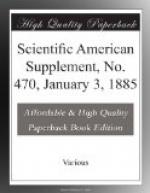the “survival of the fittest,” few who
are competent to grasp will have the temerity to doubt.
And to many, that lies within it as a doctrine, and
forms the fibre of its fabric, is the existence of
a continuity, an unbroken stream of unity running
from the base to the apex of the entire organic series.
The plant and the animal, the lowliest organized and
the most complex, the minutest and the largest, are
related to each other so as to constitute one majestic
organic whole. Now to this splendid continuity
practical biology presents no adverse fact. All
our most recent and most accurate knowledge confirms
it. But
the question is, Does this continuity
terminate now in the living series, and is there then
a break—a sharp, clear discontinuity, and
beyond, another realm immeasurably less endowed, known
as the realm of not-life? or Does what has been taken
for the clear-cut boundary of the vital area, when
more deeply searched, reveal the presence of a force
at present unknown, which changes not-living into
the living, and thus makes all nature an unbroken
sequence and a continuous whole? That this is
a great question, a question involving large issues,
will be seen by all who have familiarized themselves
with the thought and fact of our times. But we
must treat it purely as a question of science; it
is not a question of
how life
first
appeared upon the earth, it is only a question of whether
there is any natural force
now at work building
not-living matter into living forms. Nor have
we to determine whether or not, in the indefinite past,
the not-vital elements on the earth, at some point
of their highest activity, were endowed with, or became
possessed of, the properties of life.
[Illustration: Fig. 1]
On that subject there is no doubt. The elements
that compose protoplasm—the physical basis
of all living things—are the familiar elements
of the world without life. The mystery of life
is not in the elements that compose the vital stuff.
We know them all, we know their properties. The
mystery consists solely in how these
elements can be so combined as to acquire the
transcendent properties of life. Moreover, to
the investigator it is not a question of by what
means matter dead—without the shimmer
of a vital quality—became either slowly
or suddenly possessed of the properties of life.
Enough for us to know that whatever the power that
wrought the change, that power was competent, as the
issue proves. But that which calm and patient
research has to determine is whether matter demonstrably
not living can be, without the aid of organisms
already living, endowed with the properties of life.
Judged of hastily, and apart from the facts, it may
appear to some minds that an origin of life from not-life,
by sheer physical law, would be a great philosophical
gain, an indefinitely strong support of the doctrine
of evolution. If this were so, and, indeed, so




